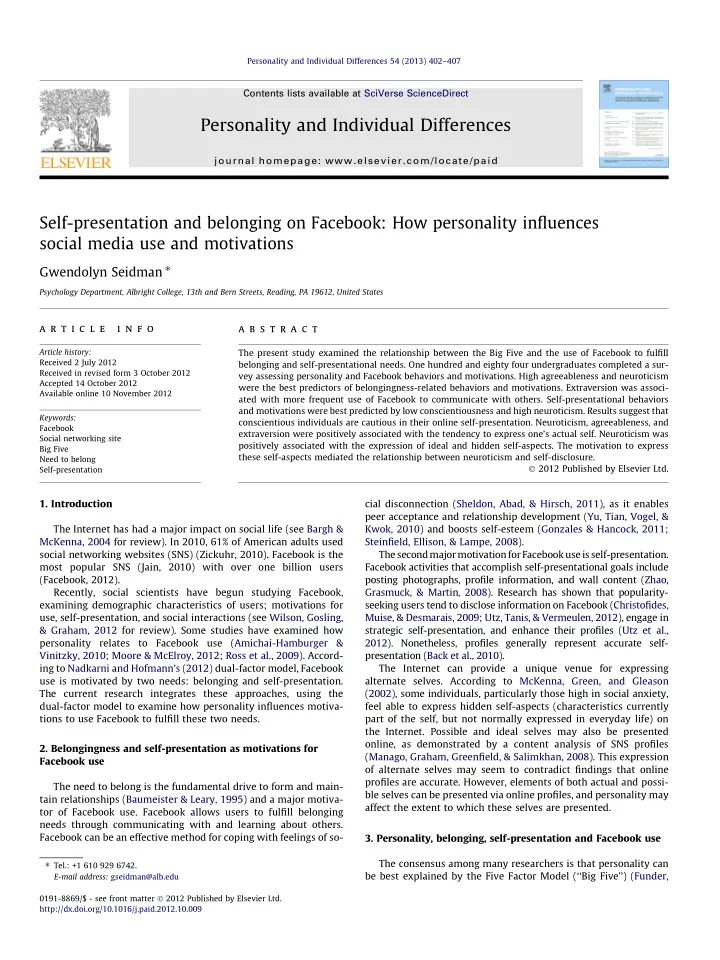

Personality and Individual Differences 54 (2013) 402–407 Contents lists available at SciVerse ScienceDirect Personality and Individual Differences journal homepage: www.elsevier.com/locate/paid Self-presentation and belonging on Facebook: How personality influences social media use and motivations Gwendolyn Seidman ⇑ Psychology Department, Albright College, 13th and Bern Streets, Reading, PA 19612, United States a r t i c l e i n f o a b s t r a c t Article history: The present study examined the relationship between the Big Five and the use of Facebook to fulfill Received 2 July 2012 belonging and self-presentational needs. One hundred and eighty four undergraduates completed a sur- Received in revised form 3 October 2012 vey assessing personality and Facebook behaviors and motivations. High agreeableness and neuroticism Accepted 14 October 2012 were the best predictors of belongingness-related behaviors and motivations. Extraversion was associ- Available online 10 November 2012 ated with more frequent use of Facebook to communicate with others. Self-presentational behaviors and motivations were best predicted by low conscientiousness and high neuroticism. Results suggest that Keywords: conscientious individuals are cautious in their online self-presentation. Neuroticism, agreeableness, and Facebook extraversion were positively associated with the tendency to express one’s actual self. Neuroticism was Social networking site positively associated with the expression of ideal and hidden self-aspects. The motivation to express Big Five these self-aspects mediated the relationship between neuroticism and self-disclosure. Need to belong � 2012 Published by Elsevier Ltd. Self-presentation cial disconnection (Sheldon, Abad, & Hirsch, 2011), as it enables 1. Introduction peer acceptance and relationship development (Yu, Tian, Vogel, & The Internet has had a major impact on social life (see Bargh & Kwok, 2010) and boosts self-esteem (Gonzales & Hancock, 2011; McKenna, 2004 for review). In 2010, 61% of American adults used Steinfield, Ellison, & Lampe, 2008). social networking websites (SNS) (Zickuhr, 2010). Facebook is the The second major motivation for Facebook use is self-presentation. most popular SNS (Jain, 2010) with over one billion users Facebook activities that accomplish self-presentational goals include (Facebook, 2012). posting photographs, profile information, and wall content (Zhao, Recently, social scientists have begun studying Facebook, Grasmuck, & Martin, 2008). Research has shown that popularity- examining demographic characteristics of users; motivations for seeking users tend to disclose information on Facebook (Christofides, use, self-presentation, and social interactions (see Wilson, Gosling, Muise, & Desmarais, 2009; Utz, Tanis, & Vermeulen, 2012), engage in & Graham, 2012 for review). Some studies have examined how strategic self-presentation, and enhance their profiles (Utz et al., personality relates to Facebook use (Amichai-Hamburger & 2012). Nonetheless, profiles generally represent accurate self- Vinitzky, 2010; Moore & McElroy, 2012; Ross et al., 2009). Accord- presentation (Back et al., 2010). ing to Nadkarni and Hofmann’s (2012) dual-factor model, Facebook The Internet can provide a unique venue for expressing use is motivated by two needs: belonging and self-presentation. alternate selves. According to McKenna, Green, and Gleason The current research integrates these approaches, using the (2002), some individuals, particularly those high in social anxiety, dual-factor model to examine how personality influences motiva- feel able to express hidden self-aspects (characteristics currently tions to use Facebook to fulfill these two needs. part of the self, but not normally expressed in everyday life) on the Internet. Possible and ideal selves may also be presented online, as demonstrated by a content analysis of SNS profiles 2. Belongingness and self-presentation as motivations for (Manago, Graham, Greenfield, & Salimkhan, 2008). This expression Facebook use of alternate selves may seem to contradict findings that online profiles are accurate. However, elements of both actual and possi- The need to belong is the fundamental drive to form and main- ble selves can be presented via online profiles, and personality may tain relationships (Baumeister & Leary, 1995) and a major motiva- affect the extent to which these selves are presented. tor of Facebook use. Facebook allows users to fulfill belonging needs through communicating with and learning about others. Facebook can be an effective method for coping with feelings of so- 3. Personality, belonging, self-presentation and Facebook use The consensus among many researchers is that personality can ⇑ Tel.: +1 610 929 6742. be best explained by the Five Factor Model (‘‘Big Five’’) (Funder, E-mail address: gseidman@alb.edu 0191-8869/$ - see front matter � 2012 Published by Elsevier Ltd. http://dx.doi.org/10.1016/j.paid.2012.10.009
Recommend
More recommend